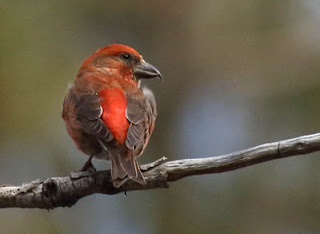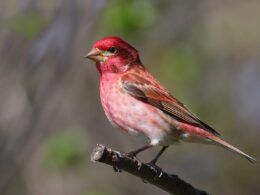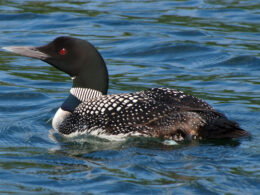Last Updated on January 20, 2024 by Greg Gillson
House Finches (Haemorhous mexicana) are small songbirds common in towns across the United States. They are common yard and feeder birds.
This page is a supplement to the main overview page on attracting House Finches. That page leads to other in-depth articles on where House Finches live, discusses courtship and nesting, and discusses their diet and what kinds of food attracts them to your feeder. I’ll link to that overview page again at the end of this article.
This article will discuss what finches look like generally, then the exact plumage of House Finches to help you identify them certainly. We’ll discuss the songs and calls. Finally we’ll discuss other similar species and how to tell them apart.
 |
|
Female House Finch
Photo by Greg Gillson
|
Finch identification, in general
Finches can look similar to sparrows and buntings. Indeed, they have been classified together more closely in the past. All have thick conical bills for eating seeds. Finches keep this seed eating diet all year, while sparrows and buntings often eat insects when available, especially when feeding young.
Finches are small birds with more upright posture that usually spend more time in trees. Sparrows usually spend most of their time feeding on the ground with a more a horizontal posture.
Finches tend to have shorter tails than sparrows. Most finch tails are strongly forked; many sparrows have round tails, but can be short or long.
When flying, finches tend to fly to fly strong and high with undulating flight. When they fly away they often land up in tree tops. Most sparrows fly low, often weakly, sometimes with tail pumping. When they fly away, most sparrows tend to dive into nearby dense bushes for cover. These are just average tendencies of the groups as a whole. The House Finch tends more toward the sparrow shape and behavior, as we’ll see below.
There are about 177 species in the Finch Family (Fringillidae) using the latest classification. This family used to include old word buntings and was much larger. Scientists used to use external characters to determine relationships. Now most use DNA. And they aren’t done yet reclassifying certain groups of birds, including the finches.
House Finches have recently been placed with two other red North American finches into the genus Haemorhous. The other two are Purple Finches and Cassin’s Finches. These other two appear to have bigger heads because of longer feathers on the crown. They have shorter, more notched tails. We’ll talk more about them in the similar species identification paragraphs below.

House Finch identification
House Finches are about 5-3/4 inches long, bill tip to tail tip. Their wingspan is about 10 inches. They average about 21 grams in weight.
Among the red finches in North America, House Finches are a bit slimmer. The head is flatter on top and more rounded at the back than Purple or Cassin’s Finch. The tail is longer than those other two and not as deeply notched.
Plumage
House Finches of both sexes are rather grayish above streaked with brown. The belly is dusky white with long wide brown streaks or lines on the flanks. The wings are brown but each feather is edged with a thin pale margin. These are wider on the greater and especially the median wing coverts, forming narrow pale wing bars. The tail is brownish.
The bill is dark gray, slightly paler toward the lower base. It is fairly short and stout. It is conical in shape but slightly curved on the upper ridge.
Male House Finches are reddish on the head, breast, and rump. The coloration is brightest on the forehead, throat and upper breast. The red forehead and throat borders a brown ear covert.
The head of the female House Finch is very weakly patterned. It is pretty much evenly marked with very short gray-brown streaks throughout. The eyebrow is only fairly paler, as is the lower border of the ear cover. All-in-all the head of the female House Finch looks unpatterned.
The exact color and intensity of the male’s red plumage is strongly influenced by diet. The color is often red-orange. Rarely is the color a deeper pure red. Frequently the coloration is orange, sometimes yellow-orange, rarely yellow. The red color comes from carotenoids in the diet during feather growth.
 |
|
A yellow House Finch
Photo by Greg Gillson
|
Flight style
House Finches in flight look small, but fairly slim and long tailed. The wings are short and rounded.
House Finches have fluttery flight and kind of bounce and jerk along. The flight path is not strongly undulating as it is in goldfinches, for instance. Bursts of rapid flapping are interspersed with a close-winged pause every 5-8 flaps or so, typical of flap-bound flight so common in smaller songbirds.
Birds generally fly in loose unorganized flocks, not too close together. Flocks have frequent stragglers. They don’t flap and turn together in unison as do some flocking birds.
Voice
What do House Finches sound like? Well, their calls are a soft squeaky or whiny calls and chirping. Both genders seem to call back and forth with each other nearly continuously. In flight one hears slightly louder chirping as the flock takes off. One of their common calls is a slightly rising queet? note.
Both sexes sing, the male louder and from an exposed perch. The song is lively, quick, rising and falling with no discernable pattern. There is often a buzzy or burry note mid-song. The song nearly always ends with a burry weeer.

Similar species
There are a few birds very similar to the red male House Finches. At your feeder, though, House Finches are probably much more likely than the other similar birds that live in northern or western forests.
The striped brown females, though, may be mistaken for any number of other brown sparrows. I’ll discuss all these below.
Other red finches
Purple Finch vs House Finch
Telling House Finches and Purple Finches apart is a challenge for most bird watchers. Once you learn their calls and habitat preferences, you will know which one to expect.
Purple Finches breed in conifer forests. I often find them in deciduous trees within the conifer forests, frequently along stream bottoms. In the summer they mostly live in Canada, the Northeast, and along the West Coast.
In winter, though, they move south, especially into the Southeast United States. At this time they may be found frequently in the tops of tall deciduous trees in town and along rivers. But they may also visit feeders.
The rollicking song of the Purple Finch has no harsh notes as does House Finch. In the West the Purple Finch song is much faster than Eastern birds and patterned in repeating phrases. I think it sounds like: hurry-little, hurry-little, hurry-little, hup, hup!
The unique call of Purple Finch is a single plik!, often given as a flight call. In the forest is also gives a vireo-like whining chuwee.
The Purple Finch seems to have every feather with a tinge of rose-pink. On this photo immediately below note two things.
The red is not just on the forehead, but goes over the crown. The whole top of the head is red in Purple Finch. The House Finch has a bright red forehead but brown crown.
There are no strong lines of dark brown striping on the under part sides of the Purple Finch, as with House Finches.
 |
|
Male Purple Finch
Photo by Greg Gillson
|
This view of Purple Finch shows the rather greenish-brown back and wing feathers, tinged throughout with pink. House finch wing feather appear flat gray-brown, not olive-greenish. (You can click on the photo to make it larger.)
 |
|
Male Purple Finch
Photo by Greg Gillson
|
With female finches you need to look at the head stripe pattern. See the pale eyebrow and pale stripe under the solid brown ear covert on this female Purple Finch below? The head of female House Finch has not pattern like this. Female House Finches are evenly marked in short dark streaks on the entire head.
 |
|
Female Purple Finch
Photo by Greg Gillson
|
Here is a decent video discussing the separation of male House Finches and Purple Finches. For the females he says: “good luck.” No! I find the females actually easier to immediately identify because of the head pattern on Purple Finch and lack of pattern on House Finch.
Cassin’s Finch
If you are in the ponderosa forests in mountains of the West, you will find Cassin’s Finches. Purple Finches are higher up in the wetter firs. House Finches are lower down in town. But you may find all three at the very few feeders at the ski resorts or high towns (I’m thinking Lake Tahoe, for instance).
Cassin’s Finches seem paler than House and Purple Finches. The males are delicately tinged with pink. Both genders show a thin white eye ring. They have thin dark streaks on the white under tail coverts.
Notice on this male Cassin’s Finch below that the red crown really stands out with red. But the breast is very delicate pink.
The voice is delicate, too. The song is broken and warbled. I think it sounds about half way between House Finch and Purple Finch. I use the ponderosa pine habitat to help identify the song that I can’t quite tell apart from the other two. I don’t get enough practice at it. And practice and familiarity is the key to learning bird songs.
 |
|
Cassin’s Finch
Photo by Greg Gillson
|
This female Cassin’s Finch has a broad clean white line under the dark ear covert. She is similar to the female Purple Finch, but the pale head pattern is even cleaner. There is no green cast to the brown upper part feathers as there is on Purple Finches. Note the forked tail. [Click on the photos to make them a bit larger.]
The streaks on the underparts of the female Cassin’s Finches are thin, short, and darker than under part streaking on House or Purple Finches.
 |
|
Female Cassin’s Finch
Photo by Greg Gillson
|
Red Crossbill
Red Crossbills are finches with big round heads and short forked tails. Males can be red or orange. Females are yellowish. The bird below is the form found in ponderosa pine forests. It has the largest bills. Other forms, such as those found in spruce forests, have thinner small bills.
They have a warbling song, but it is the harsh kip-kip calls that give them away. They are almost always in flocks of a dozen or more birds.
 |
|
Red Crossbill
Photo by Greg Gillson
|
Common Redpoll
These are rare visitors in winter to weedy fields and alder catkins the northern United States. They look more like little goldfinches with red caps and a black chin.
 |
|
Common Redpoll
Photo by Greg Gillson
|
Other species
Here are some common brown feeder birds that you need to learn to separate from female House Finches.
House Sparrow
Female House Sparrows are very likely at feeders with female House Finches. House Sparrows are a bit more squat. They have a larger flatter head and shorter tail. They have a more horizontal posture. They have no striping underneath, though.
Male House Sparrows have a black throat and gray crown. They make chirping sounds similar to House Finches.
 |
|
Female House Sparrow
Photo by Greg Gillson
|
Song Sparrow
Song Sparrows do not flock. They are more common in brushy areas and marshes. But they are widespread through backyards with larger hedges and bushes. They like to stay on the ground for the most part.
The striping on Song Sparrows is heavy on the upper breast where the streaks converge into a central breast spot. The head is strongly striped on crown, eyes stripe, and side of throat. This is unlike the rather plain head of the female House Finch.
 |
|
Song Sparrow
Photo by Greg Gillson
|
Pine Siskin
These tiny little birds are like striped goldfinches. They have a thin pointed bill, thick at the base. They frequent feeders in winter in large flocks in the North and West. They have a yellow stripe in the wing and base of the tail. Some birds are quite plain, others more yellow.
 |
|
Pine Siskin
Phot by Greg Gillson
|
Back to the overview page on attracting House Finches.
Wrapping Up
There are many reasons why House Finches are so beloved by birdwatchers and nature enthusiasts alike. Here are some of the key factors:
Appearance and personality:
- Charming looks: Male House Finches have vibrant rosy red chests and crowns, making them visually striking and attractive. Even the females, with their streaked brown plumage, hold an earthy charm.
- Active and lively: House Finches are full of energy, hopping, flitting, and singing with enthusiasm. This adds a dose of liveliness and entertainment to any backyard or birding spot.
- Tame and approachable: Compared to some other birds, House Finches are typically less wary of humans and readily visit feeders, allowing for close observation and appreciation.
Song and vocalizations:
- Beautiful melody: The male House Finch’s song is a bright, cheerful melody, often ending in a long, drawn-out “veeerrr.” This sound brings a touch of musicality and joy to the natural environment.
- Variety and individuality: Each House Finch has its own variations in its song, adding a layer of intrigue and uniqueness to their vocalizations.
Adaptability and abundance:
- Widespread and familiar: House Finches are found across a vast range of North America, making them familiar to birders in diverse locations. They’re a common sight in backyards, parks, and open spaces.
- Easy to attract: By providing feeders with suitable seeds, you can readily attract House Finches to your backyard, allowing you to enjoy their presence regularly.
- Year-round residents in many areas: In milder regions, House Finches are present throughout the year, offering a constant source of delight and connection to nature.
Frequently Asked Questions
Are House Finches good to have around?

Yes, House Finches are generally considered good to have around for several reasons:
- Seed dispersal: House Finches play a vital role in seed dispersal, consuming and dropping seeds of various plants, which contributes to the health and regeneration of plant communities.
- Insect control: They feed on some insects, including mosquitoes and gnats, helping to keep these pest populations in check.
- Beautiful song: The male House Finch has a cheerful and melodic song, which adds a pleasant layer of sound to the natural environment.
- Aesthetics: Their vibrant red breasts (males) and streaked plumage (females) offer a visually appealing element to gardens and natural spaces.
- Nature connection: Observing House Finches can create a sense of connection to nature and provide enjoyment for birdwatchers and nature enthusiasts.
- Indicators of healthy environment: Their presence can be an indicator of a healthy and diverse ecosystem with abundant food and nesting resources.
How rare are House Finches?
Contrary to what you might think, House Finches are not rare at all! They are actually one of the most common bird species in North America. Here’s why:
- Widespread range: Found from Alaska to Mexico and coast to coast, House Finches are familiar to birders in diverse locations, increasing their perceived abundance.
- Large population: Estimates suggest over 40 million breeding pairs in North America alone, making them numerically abundant across their range.
- Adaptability to habitats: These finches thrive in various settings, from forests and open fields to suburban gardens and city parks, further enhancing their encounter rate.
- Regularly observed: With their year-round presence in many regions and frequent visits to feeders, House Finches are readily seen and enjoyed by birdwatchers of all levels.
While their populations have slightly declined in recent decades due to habitat loss and other factors, they remain abundant overall. Partners in Flight even rates the species as 8 out of 20 on the Continental Concern Score, indicating low conservation concern.
Do House Finches come back to the same nest every year?
While House Finches may not return to the exact same nest every year, they do exhibit a strong tendency to return to the same breeding area and sometimes even reuse old nest sites under certain conditions.
Female House Finches have a higher fidelity to nesting sites than their male counterparts. They may reuse the same nest or build a new one nearby if the old one is damaged or unsuitable.
Reuse is more likely if the previous nesting attempt was successful, the nest site is safe and sheltered, and the necessary materials are readily available. If they do reuse an old nest, the female will typically remove the old lining and replace it with fresh materials before laying eggs.
Both male and female House Finches tend to return to the same breeding area year after year. This familiarity with the environment provides them with advantages in finding food, shelter, and potential mates. Males actively defend their breeding territory against other males, ensuring access to resources and potential mates for successful breeding.
Overall, while not guaranteed, House Finches often return to the same breeding area and may even reuse old nests under favorable conditions. This behavior demonstrates their strong attachment to familiar territory and their efficient use of resources.










